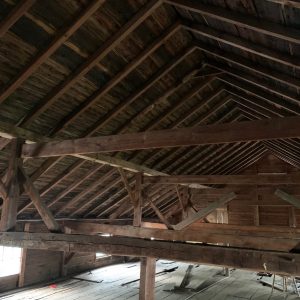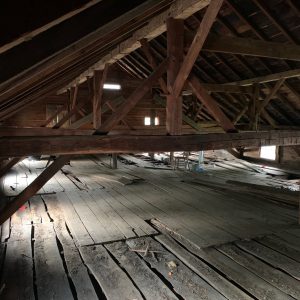1850s Tavern Roof Structure
I own an old Tavern (1850) that I have been working on for a couple years. I might be getting a new roof installed, and I’m trying to decide what I should do to improve the building structure.
Background on the building. Built in 1850 as a shingle mill. Later converted to a Tavern with apartments.
The building construction style is called “Stacked Plank Construction”. Rather than a framed structure, the building is made of 2×4 sawn lumber laid down flat and nailed together. This means the exterior walls of the building are 4” thick solid lumber, this can be seen in my photos.
The roof structure is supported by 6 large axe hewn timber frames, pegged together. A purloin runs the length of the building at mid roof. Pictures of this included.
The issue: as was a common issue with this construction, the weight of the roof put and outward pressure on the walls. A very long time ago someone arrested this with a metal tie rod with a turnbuckle which runs through the exterior wall and is bolted to a plate on the outside.
I would like to increase the strength of this structure so that I don’t have any issues in the future. I would like to install rafter ties and ridge straps or collar ties. I’m not certain how I should go about this because of the unusual construction, the roof starts above the joists. I’m curious what people would do to create this tie system, and how it would be supported across its length.
Other suggestions would be appreciated.





















Replies
The first place I’d start is with the floor. That’s the lowest support point to keeping the walls from bowing out. I’m curious as to how it currently ties into the walls. But I’d think a rim joist with timber lock screws, then floor joists hung off that with joist hangers installed with screws and maybe some hardware that prevents the rim joist from pulling away from the floor joist. That is basically like the bottom of the triangle of the roof. I’d then install tho sets of collar ties. One low and one high. If you really want to get crazy brace from the end of the upper collar tie to the middle of the lower tie and basically make your own truss.